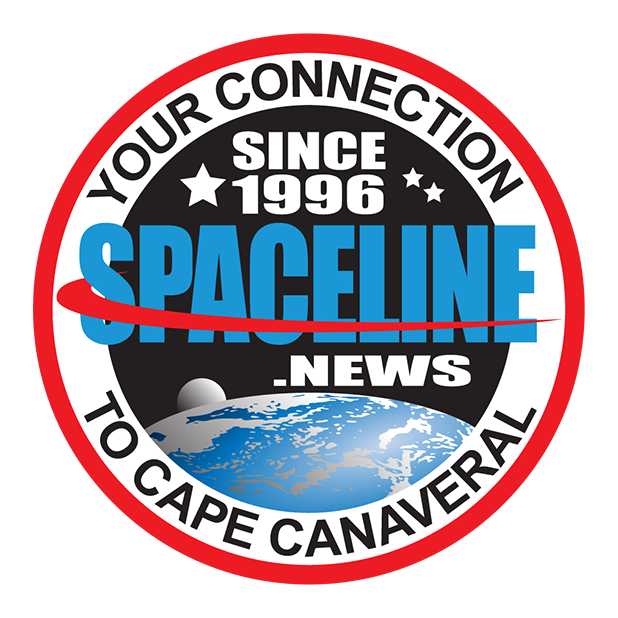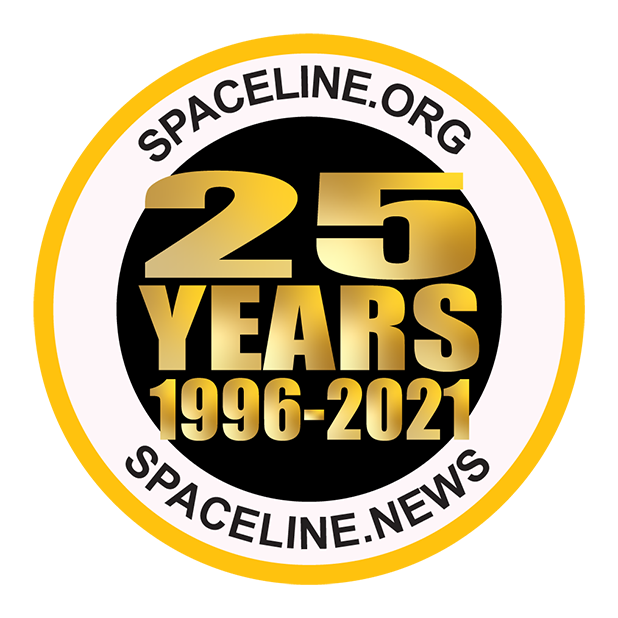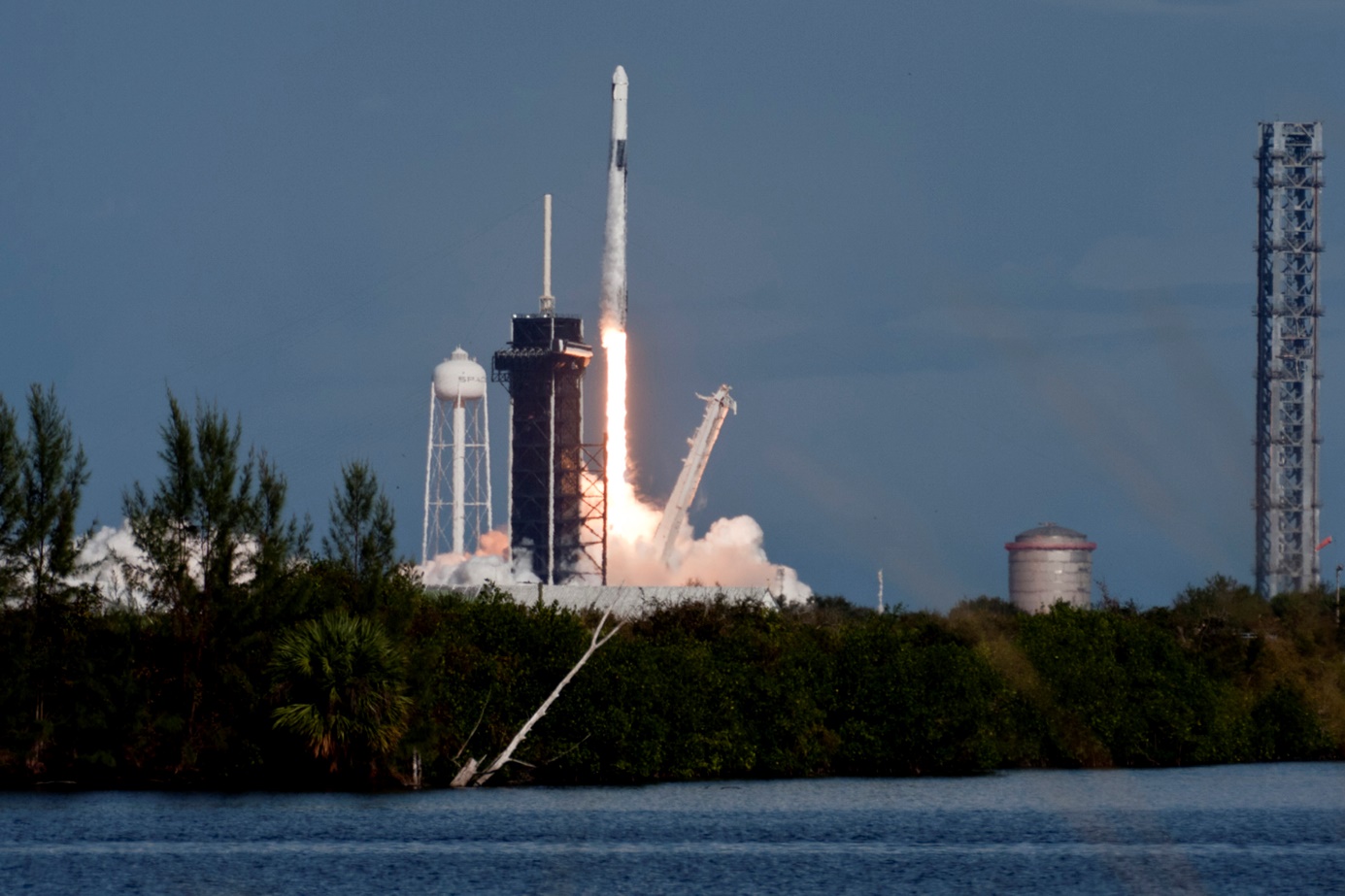
Falcon 9 CRS-26 Launch, Photo Courtesy Carleton Bailie/Spaceline
Falcon 9 Launches CRS-26 Payload For NASA
November 26, 2022 | Reported by Cliff Lethbridge
A SpaceX Falcon 9 rocket successfully launched the CRS-26 payload for NASA at 2:20 p.m. EST today from Launch Pad 39A at the Kennedy Space Center. Launch was originally set for November 22, 2022 but was postponed due to bad weather at the launch site. The first stage booster employed today was being flown for the first time and was successfully recovered with a landing on the "Just Read the Instructions" drone ship positioned on the Atlantic Ocean about 200 miles northeast of Cape Canaveral.
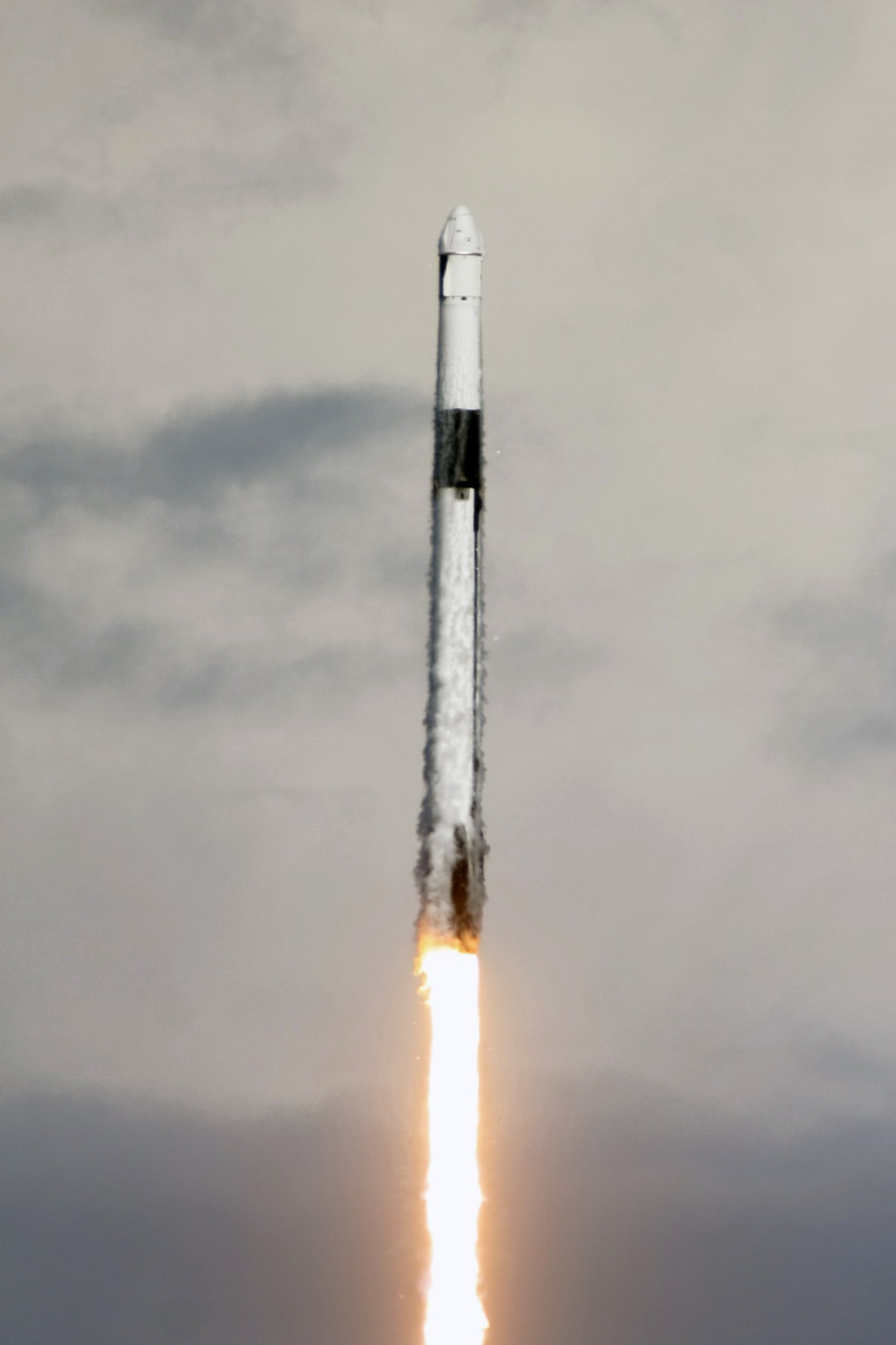
Falcon 9 CRS-26 Launch, Photo Courtesy Carleton Bailie/Spaceline
This was the 26th cargo mission to the International Space Station (ISS) under the Commercial Resupply Services contract between NASA and SpaceX. The Cargo Dragon spacecraft launched today was being flown for the first time and carried about 7,700 pounds of hardware, supplies and experiments to support the ISS seven-member crew. Highlights of the cargo carried aboard CRS-26 include a pair of rollout solar arrays to augment electricity aboard ISS, an experiment in the space-based growth of dwarf tomatoes, a GPS and navigation device for ISS and eight small cubesat satellites to be deployed by the ISS crew. CRS-26 is set to autonomously dock to ISS at about 7:30 a.m. EST on November 27, 2022.
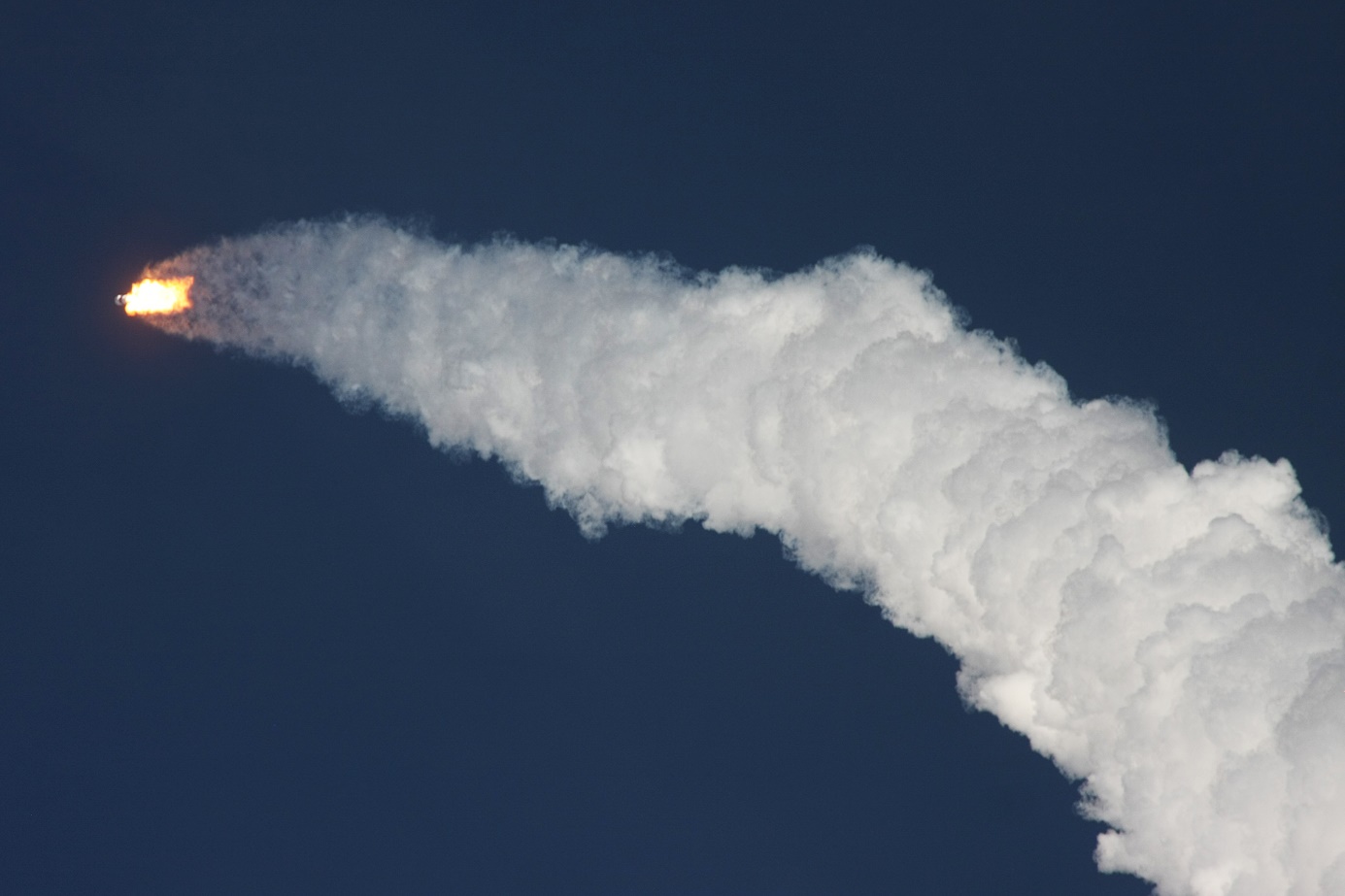
Falcon 9 CRS-26 Downrange, Photo Courtesy Carleton Bailie/Spaceline
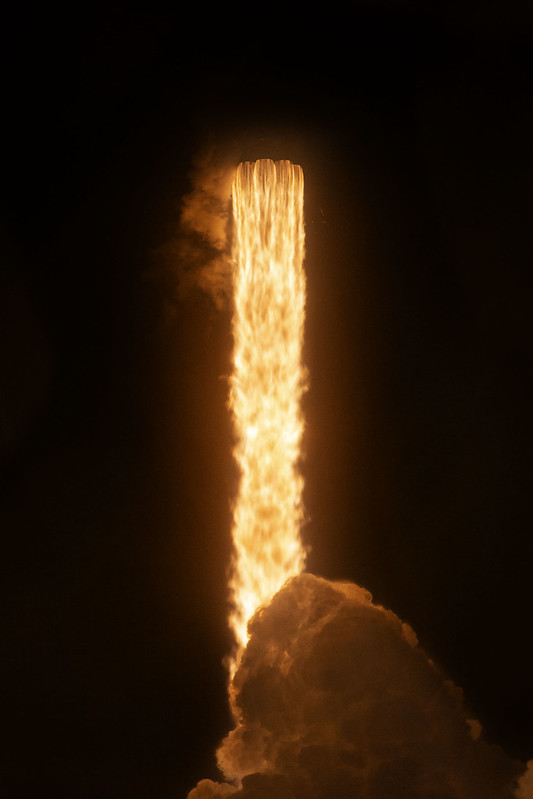
Falcon 9 Eutelsat-10B Launch, Photo Courtesy SpaceX
Falcon 9 Launches Eutelsat-10B Satellite
November 22, 2022 | Reported by Cliff Lethbridge
A SpaceX Falcon 9 rocket successfully launched the Eutelsat-10B satellite at 9:57 p.m. EST today from Launch Pad 40 on Cape Canaveral Space Force Station. Launch was delayed a day to allow additional checkouts of the rocket. The first stage booster employed today was being flown for the eleventh time, having previously supported the Telstar-18 VANTAGE, Iridium-8 and eight Starlink missions. The booster was not recovered today to allow it to expend all of its fuel placing the satellite in a high orbit. Owned and operated by Eutelsat and built by Thales Alenia Space, the 12,000-pound Eutelsat-10B satellite is intended to provide broadband, data and video services to maritime and in-flight customers in the Americas, Atlantic Ocean, Europe, Africa, the Middle East and Central Asia. The satellite will be deployed to a geosynchronous orbit at an altitude of about 22,000 miles above Earth at ten degrees east longitude.
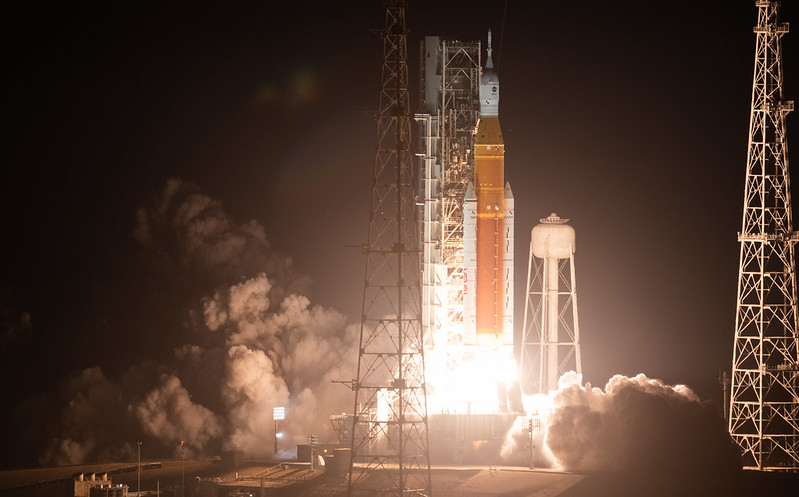
Space Launch System Artemis-I Launch, Photo Courtesy NASA
Space Launch System Launches Artemis-I Mission
November 16, 2022 | Reported by Cliff Lethbridge
NASA's Space Launch System rocket successfully launched the Artemis I mission at 1:47 a.m. EST today from Launch Pad 39B at the Kennedy Space Center. Launch was delayed 43 minutes to allow a fix to a range safety radar system and to allow troubleshooting of a liquid hydrogen leak at the base of the rocket. The primary objectives of the Artemis I flight test are to demonstrate the Orion heat shield at lunar return re-entry conditions, demonstrate operations and facilities during all mission phases, and retrieve the spacecraft after splashdown. In the course of completing these goals, the team aims to successfully demonstrate the SLS rocket's capability, carry out the mission as planned, and ensure a safe return prior to the first flight with crew on Artemis II. Additional secondary objectives will be accomplished as possible throughout the mission that may support future development or mission planning efforts. These objectives will enable NASA to evaluate the performance of Orion, SLS, and the supporting ground systems for certification of the respective systems that will support future crewed missions.
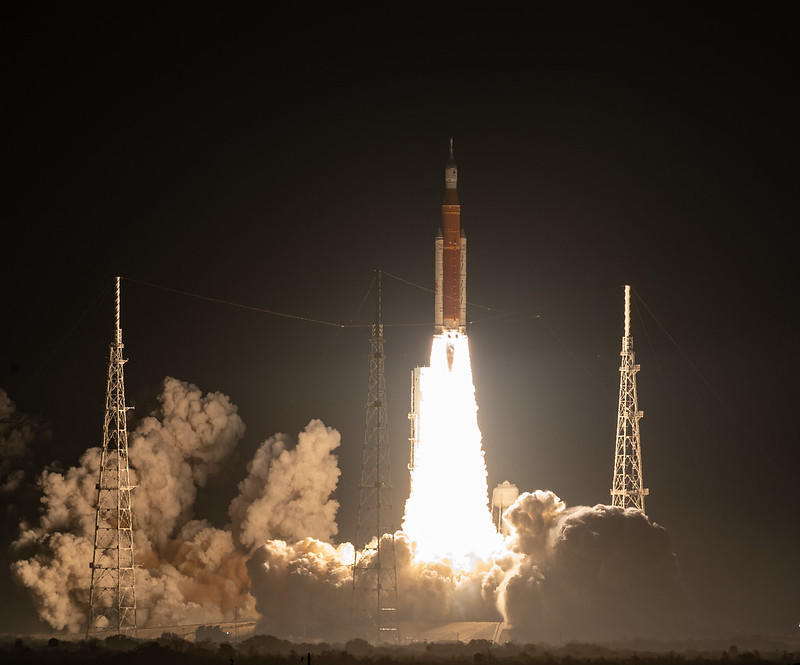
Space Launch System Artemis-I Launch, Photo Courtesy NASA
Propelled by a pair of five-segment boosters and four RS-25 engines, the rocket reached the period of greatest atmospheric force within 90 seconds. The solid rocket boosters burned through their propellant and separated after approximately two minutes, and the core stage and RS-25's depleted propellant after approximately eight minutes. After jettisoning the boosters, service module panels, and launch abort system, the core stage engines shut down and the core stage separated from the spacecraft, leaving Orion attached to the interim cryogenic propulsion stage (ICPS) that propelled it toward the Moon. After the spacecraft made an orbit of Earth and deployed its solar arrays, the ICPS gave Orion the big push it needed to leave Earth's orbit and travel toward the Moon. This maneuver, known as the trans-lunar injection, precisely targets a point about the Moon that will guide Orion close enough to be captured by the Moon's gravity.
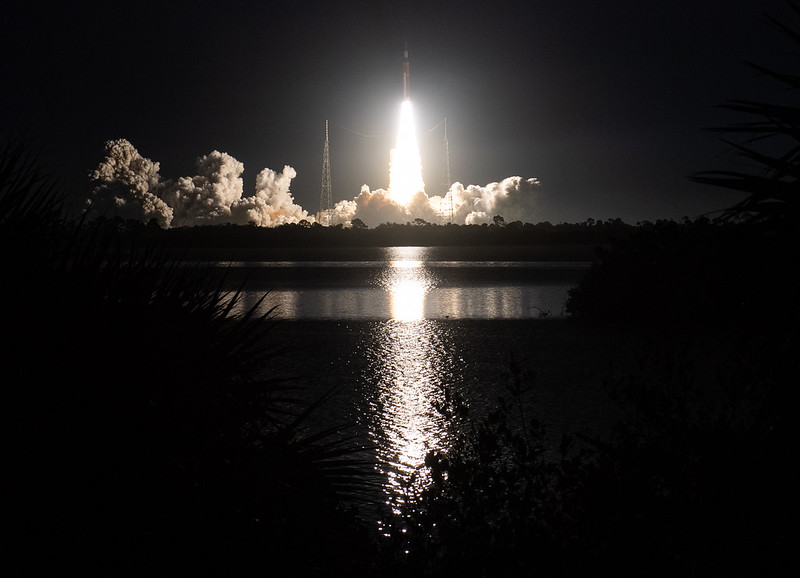
Space Launch System Artemis-I Launch, Photo Courtesy NASA
Orion separated from the ICPS approximately two hours after launch. The ICPS then deployed ten small satellites, known as CubeSats, along the way to study the Moon or head father out to deep space destinations. As Orion continues on its path from Earth orbit to the Moon, it will be propelled by a service module provided by ESA (European Space Agency) that will course-correct as needed along the way. The service module supplies the spacecraft's main propulsion system and power. The outbound trip to the Moon will take several days, during which time engineers will evaluate the spacecraft's systems. Orion will fly about 60 miles above the surface of the Moon at its closest approach, and then use the Moon's gravitational force to propel Orion into a distant retrograde orbit, traveling about 40,000 miles past the Moon. This distance is 30,000 miles farther than the previous record set during Apollo 13 and the farthest in space any spacecraft built for humans has flown. For its return trip to Earth, Orion will get another gravity assist from the Moon as it does a second close flyby, firing engines at precisely the right time to harness the Moon's gravity and accelerate back toward Earth, setting itself on a trajectory to re-enter our planet's atmosphere.
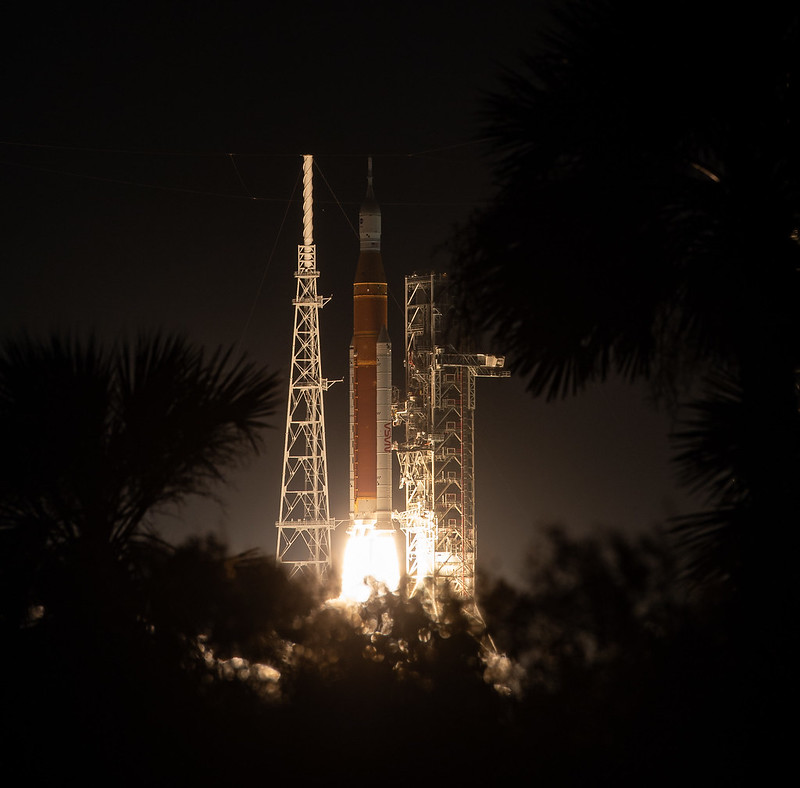
Space Launch System Artemis-I Launch, Photo Courtesy NASA
The mission will end with a test of Orion's capability to return safely to Earth. Orion will enter Earth's atmosphere traveling at about 25,000 mph. Earth's atmosphere will slow the spacecraft down to a speed of about 300 mph, producing temperatures of approximately 5,000 degrees Fahrenheit and testing the heat shield's performance. Once the spacecraft has passed this extreme heating phase of flight, the forward bay cover that protects its parachutes will be jettisoned. Orion's two drogue parachutes deploy first, at 25,000 feet, and within a minute slow Orion to about 100 mph before being released. They are followed by three pilot parachutes that pull out the three main parachutes which will slow Orion's descent to less than 20 mph. The spacecraft will make a precise landing within eyesight of the recovery ship off the coast of San Diego.
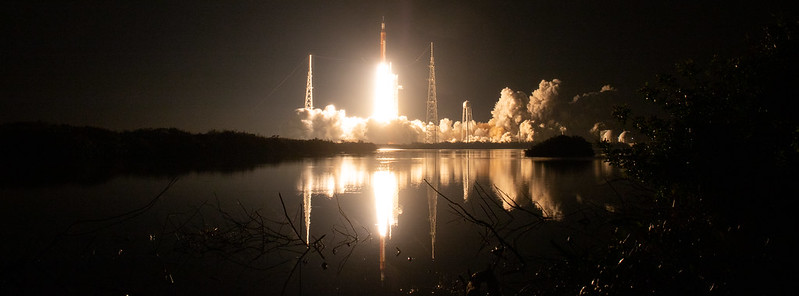
Space Launch System Artemis-I Launch, Photo Courtesy NASA
The Landing and Recovery Team, led by NASA's Exploration Ground Systems program at the Kennedy Space Center, will be responsible for safely recovering the capsule after splashdown. The interagency landing and recovery team consists of personnel and assets from the U.S. Department of Defense, including Navy amphibious specialists and Air Force weather specialists, and engineers and technicians from Kennedy, Johnson Space Center in Houston, and Lockheed Martin Space Operations. Before splashdown, the team will head out to sea in a Navy ship. At the direction of the NASA Recovery Director, Navy divers and other team members in several inflatable boats will be cleared to approach Orion. Divers will then attach a cable to the spacecraft and pull it by winch into a specially designed cradle inside the ship's well deck. The vessel will transport the spacecraft and other hardware to a pier at U.S. Naval Base San Diego for transport to Kennedy. Open water personnel will also work to recover Orion's forward bay cover and three main parachutes. If teams are able to recover the jettisoned cover and parachutes, engineers will inspect the hardware and gather additional performance data.
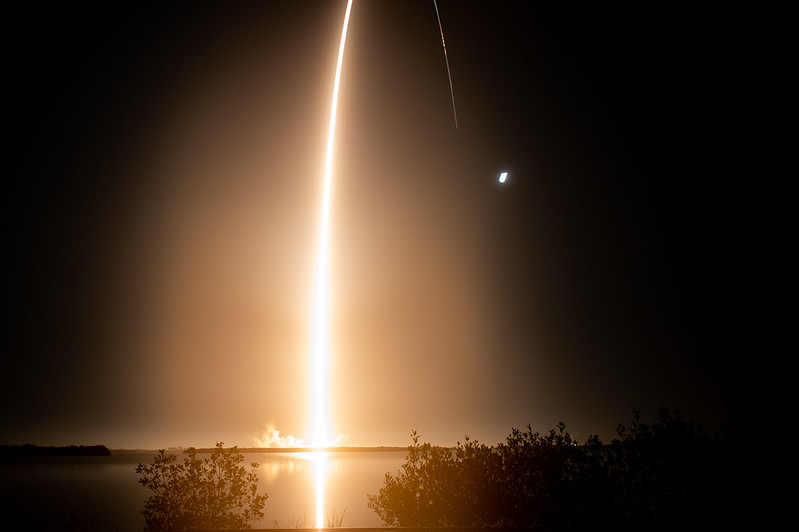
Space Launch System Artemis-I Launch, Photo Courtesy NASA
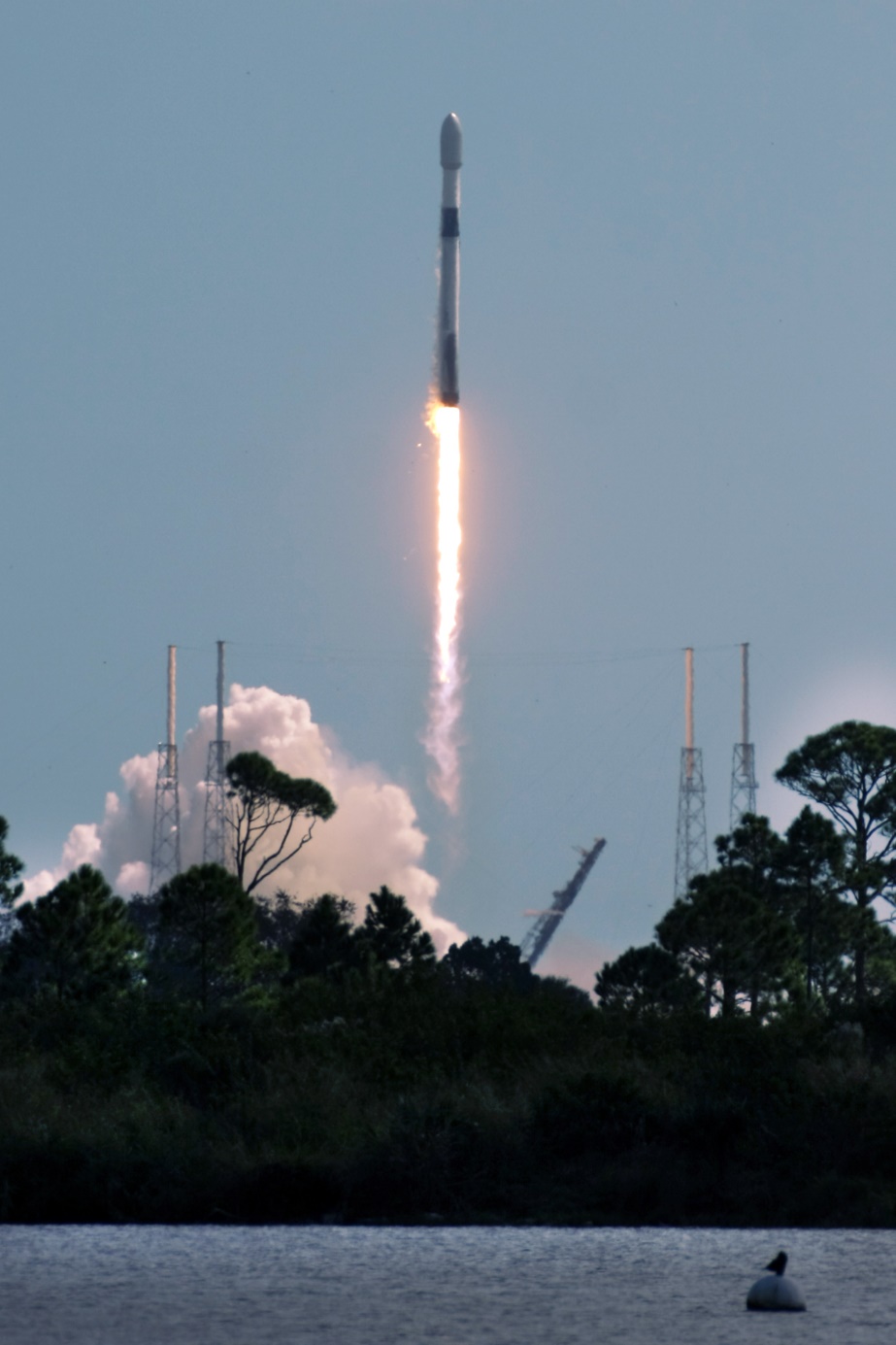
Falcon 9 Galaxy 31/32 Launch, Photo Courtesy Carleton Bailie/Spaceline
Falcon 9 Launches Galaxy 31 And Galaxy 32 Satellites
November 12, 2022 | Reported by Cliff Lethbridge
A SpaceX Falcon 9 rocket successfully launched the Galaxy 31 and Galaxy 32 satellites at 11:06 a.m. EST today from Launch Pad 40 on Cape Canaveral Space Force Station. Launch was delayed four days due to the passage of Hurricane Nicole. The first stage booster employed today was being flown for a record-tying 14th time, having previously supported the DM-2, RADARSAT, SXM-7 and ten Starlink missions. The booster was not recovered today to allow it to expend all its fuel placing the satellites in orbit, rather than completing a landing on the Atlantic Ocean. Owned and operated by Intelsat, Galaxy 31 and Galaxy 32 will provide television services for North America. They will be deployed to geosynchronous orbit about 22,000 miles above Earth, Galaxy 31 at 121 degrees west longitude and Galaxy 32 at 91 degrees west longitude. Galaxy 31 will replace Galaxy 23, launched in 2003, while Galaxy 32 will replace Galaxy 17, launched in 2007. The satellites have a design life of about 18 years.
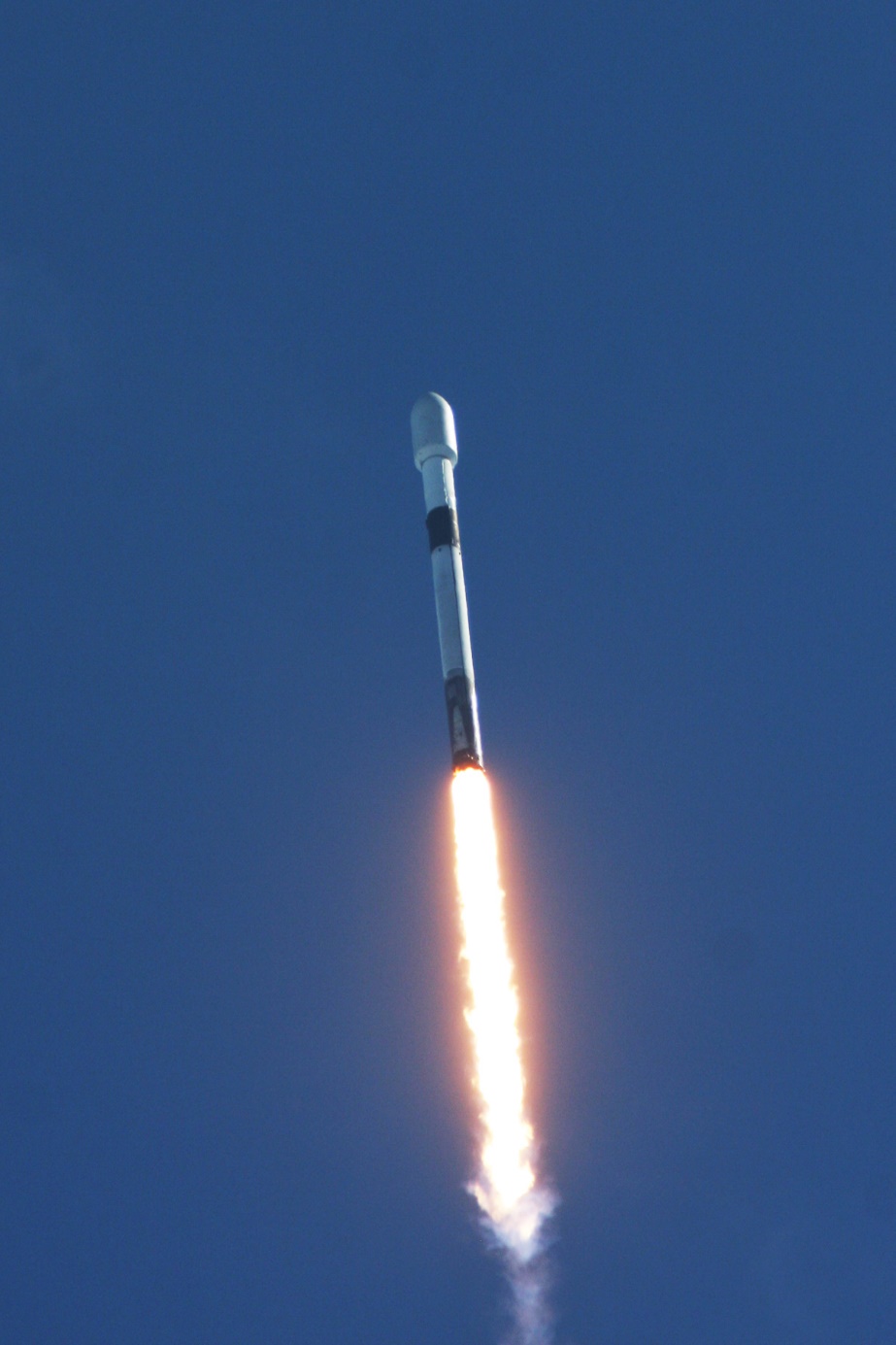
Falcon 9 Galaxy 31/32 Launch, Photo Courtesy Carleton Bailie/Spaceline
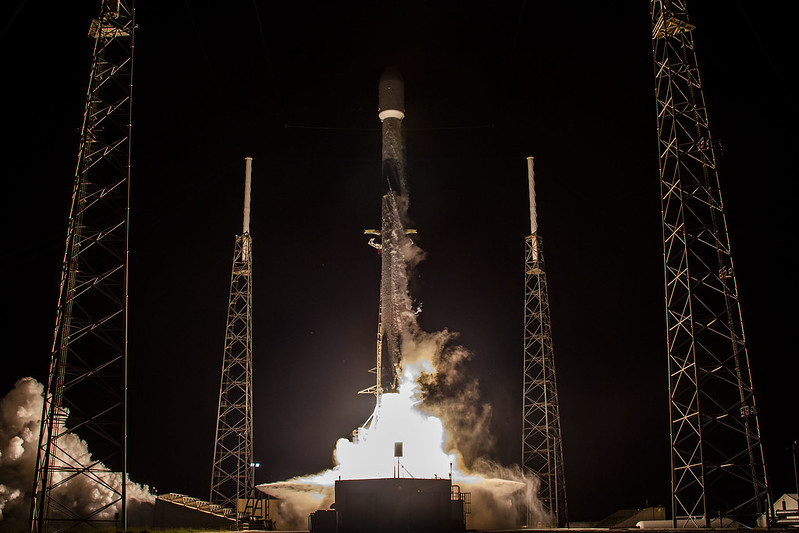
Falcon 9 Hotbird-13G Launch, Photo Courtesy SpaceX
Falcon 9 Launches Hotbird-13G Satellite
November 3, 2022 | Reported by Cliff Lethbridge
A SpaceX Falcon 9 rocket successfully launched the Hotbird-13G satellite at 1:22 a.m. EDT today from Launch Pad 40 on Cape Canaveral Space Force Station. Launch came at the conclusion of a 116-minute window to allow checkouts of the rocket. The first stage booster employed today was being flown for the seventh time, having previously supported the CRS-22, Crew-3, Turksat-5B, Crew-4, CRS-25 and one Starlink mission. The booster was successfully recovered today with a landing on the "Just Read the Instructions" drone ship, positioned on the Atlantic Ocean about 400 miles east of Cape Canaveral. The 10,000-pound Hotbird-13G satellite, owned and operated by Eutelsat and built by Airbus, will provide television and radio services to Europe, the Middle East and North Africa. It will be deployed in a geosynchronous orbit about 22,000 miles above Earth at 13 degrees east longitude. The satellite has a design life of about 15 years.
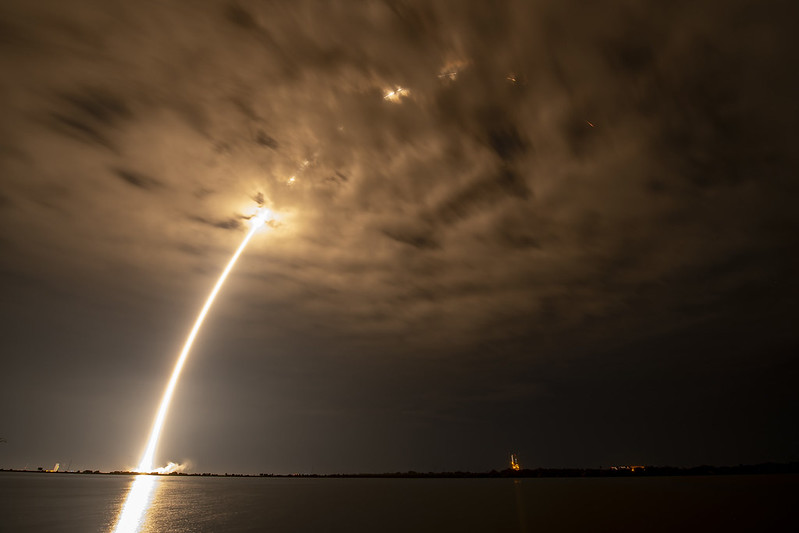
Falcon 9 Hotbird-13G Streak Shot, Photo Courtesy SpaceX
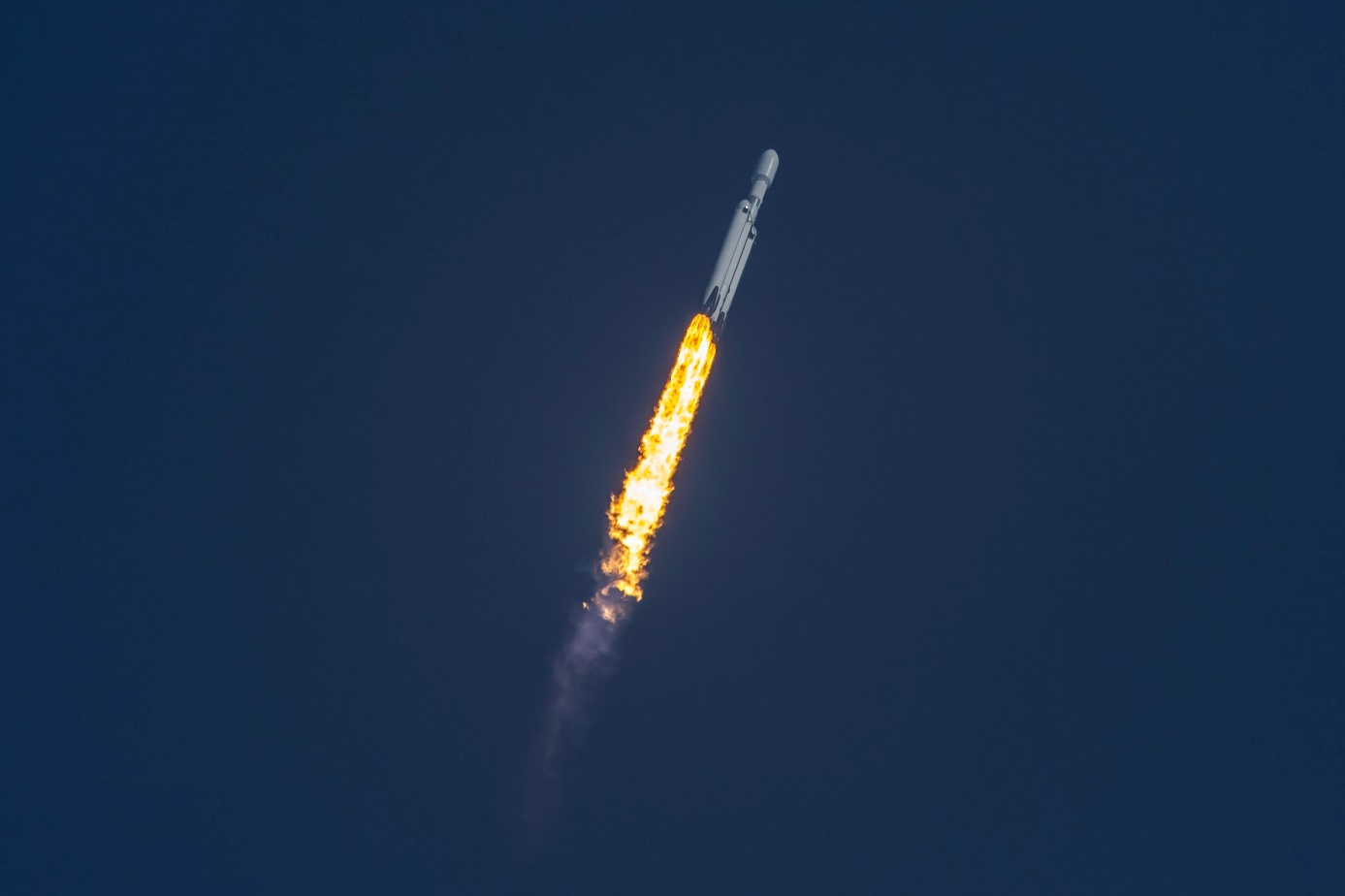
Falcon Heavy USSF-44 Launch, Photo Courtesy SpaceX
Falcon Heavy Launches Space Force Payload
November 1, 2022 | Reported by Cliff Lethbridge
A SpaceX Falcon Heavy rocket successfully launched the USSF-44 (U.S. Space Force-44) payload at 9:41 a.m. EDT today from Launch Pad 39A at the Kennedy Space Center. This was the first Falcon Heavy launch in three years. All three first stage boosters employed today were being flown for the first time. The two side boosters were successfully recovered today with a landing at Landing Zones 1 and 2 on Cape Canaveral Space Force Station. The center booster was not recovered. USSF-44 is an integrated payload which contains the Long Duration Propulsive EELV (Evolved Expendable Launch Vehicle) Secondary Payload Adapter (LDPE-2) space vehicle. The LDPE platform is a standardized satellite bus that can host multiple payloads, including separable spacecraft to leverage available mass margin on national security missions. The design is modular and employs standard interfaces that minimize engineering work required to integrate new payloads. This approach makes rideshare more affordable for a wide range of small and secondary payloads. Much about this mission remains classified.
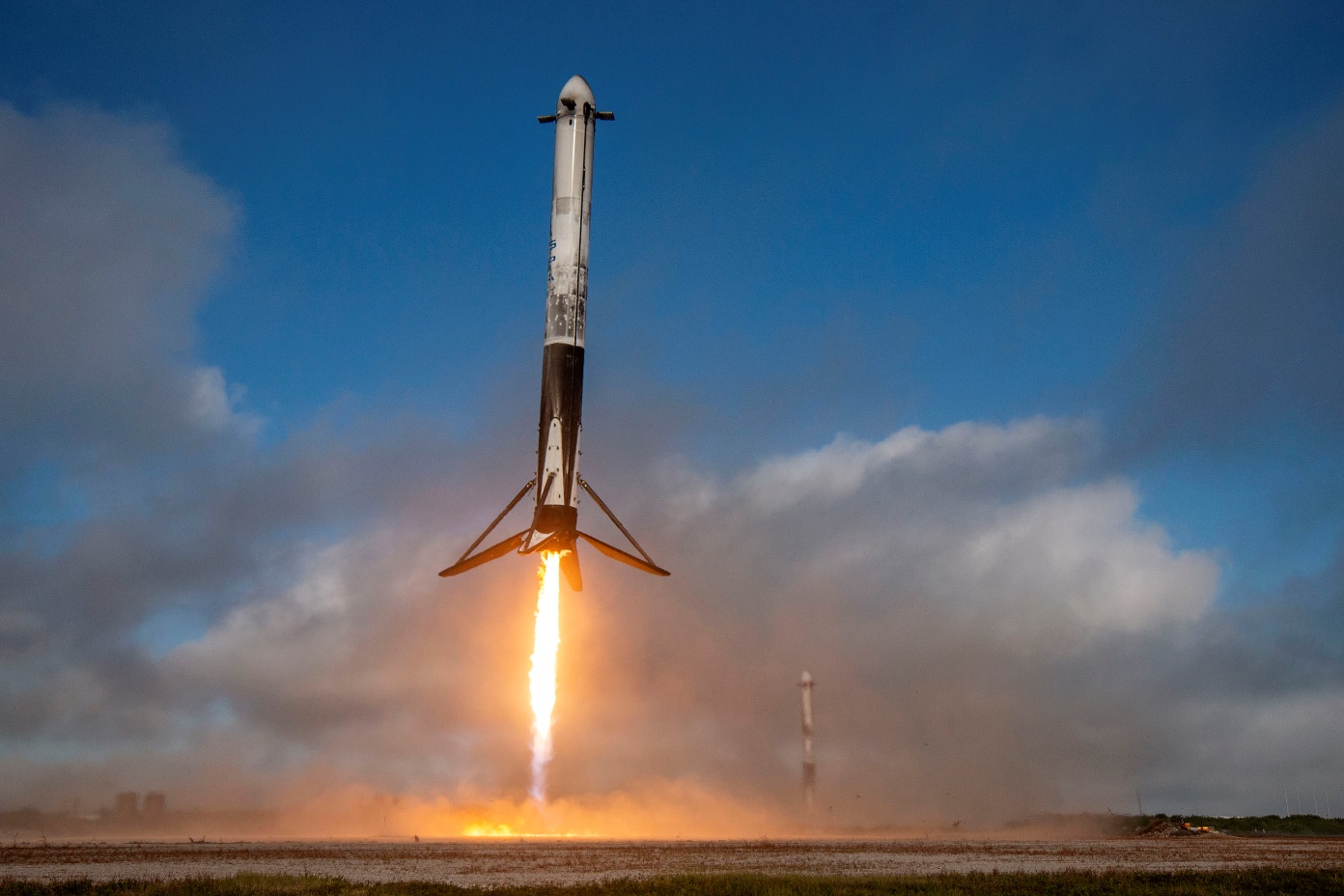
Falcon Heavy USSF-44 Side Boosters Landing, Photo Courtesy SpaceX



